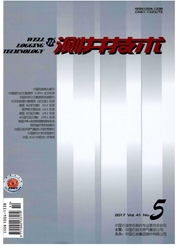

 中文摘要:
中文摘要:
二维核磁共振识别和评价储层流体是测井技术的发展方向。通过数值模拟与岩心实验,系统研究了(T2,T1)二维核磁共振方法在不同储层、不同信噪比以及不同采集参数条件下识别流体的效果。结果表明:(T2,T1)方法识别气层具有优势,通过优选最小等待时间测量值,即使信噪比为20,(T2,T1)方法也能很好地分辨束缚水、可动水和气。在油层,(T2,T1)二维核磁共振方法与双Tw测井方法相比,可以识别的油的粘度范围增大。在油水同层,当可动水和油的T2值有足够大的差异时,(T2,T1)二维核磁共振方法可以有效区分可动水和油;当可动水与油在T2分布上重叠严重时,(T2,T1)二维核磁共振方法无法分辨水和油。(T2,T1)二维方法识别油水层的效果不如(T2,D)二维核磁共振方法。
 英文摘要:
英文摘要:
Two-dimensional nuclear magnetic resonance (NMR) for typing fluid is an important development of well logging technology. Detailed is the performance of T2-T1 two-dimensional NMR method for typing fluid at different kinds of reservoirs, signal-to-noise ratios, and measuring parameters through numerical simulation and petrophysical experiments, the results of which show that T2-T1 method has advantages in typing gas layers. For a signal to noise ratio of less than 20, T2-T1 method can clearly distinguish gas, irreducible water and movable water by optimizing minimum waiting time. In oil layers, T2-T1 method can distinguish a wider range of viscosity oil than the dual-wait time method. In oil bearing water layer with movable water, T2-T1 method can distinguish movable water and oil when their T2 distributions have large differences. However, the result of T2-T1 method becomes ambiguous when the T2 signal of the oil overlaps with that of the movable water significantly. In this regard, T2-T1 method is not as good as the T2-D method in distinguishing oil and movable water.
 同期刊论文项目
同期刊论文项目
 同项目期刊论文
同项目期刊论文
 期刊信息
期刊信息
